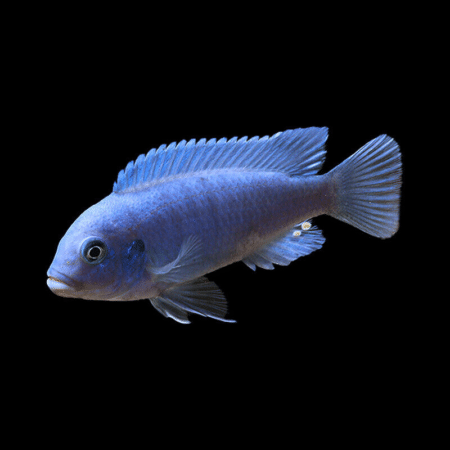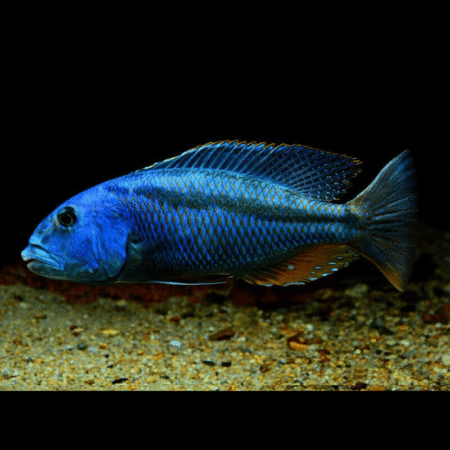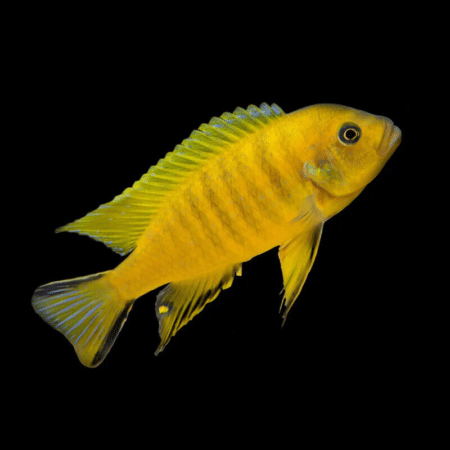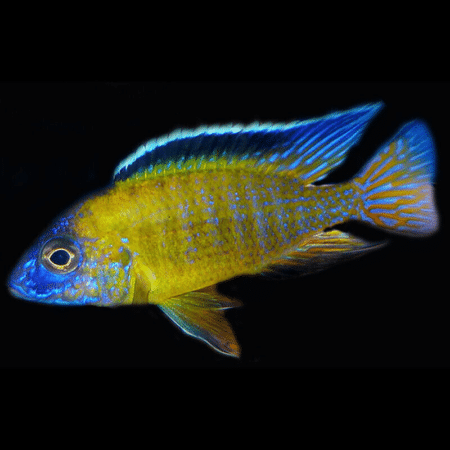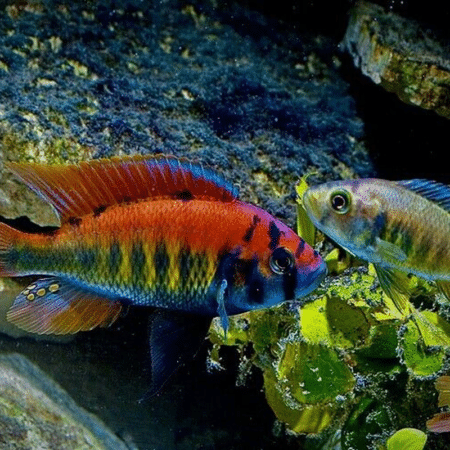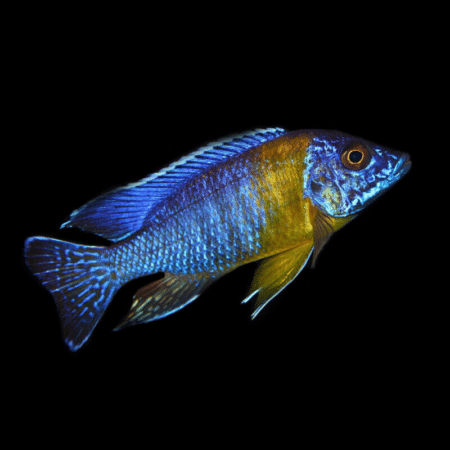Aulonocara sp. calicoCalico Peacock Cichlid Lake Malawi Cichlid 4-5 Cm, Stunning Peaceful Companions for Community Aquariums – Easy Care and Beautiful Colors
£26.99 Original price was: £26.99.£22.58Current price is: £22.58.
Welcome these stunning Aulonocara sp. calico, known for their vibrant colors and graceful movements. Ideal for community aquariums, these peaceful companions thrive in proper care. Provide a loving home and enjoy the beauty of Lake Malawi cichlids in your setup today.
Species Introduction
The Aulonocara sp. calico, commonly known as the Calico Peacock Cichlid, is a stunning species originating from the vibrant waters of Lake Malawi in East Africa. This freshwater cichlid is renowned for its striking coloration and peaceful demeanor, making it an ideal choice for community aquariums. The Calico Peacock Cichlid typically grows to a size of 4-5 cm, showcasing a unique blend of colors that can include shades of blue, yellow, and orange, often with a speckled or calico pattern that adds to its visual appeal. In its natural habitat, this species thrives in rocky environments, where it finds shelter and breeding sites among the stones and crevices. Understanding the natural behaviors and habitat of the Aulonocara sp. calico is essential for recreating a suitable environment in your aquarium, ensuring these beautiful aquatic companions flourish in your care.
Care Requirements Dashboard
| Optimal Living Conditions | |
|---|---|
| Water Temperature | 24-27°C (75-81°F) |
| pH Level | 6.5-7.5 |
| Water Hardness | 4-12 dKH |
| Minimum Tank Size | 80L (20 gal) |
| Salinity | Freshwater |
| Care Level | Beginner Friendly |
Natural Behavior & Temperament
The Calico Peacock Cichlid exhibits a peaceful temperament, making it a wonderful addition to community aquariums. These fish are known for their active swimming patterns, often darting around the tank while exploring their environment. In the wild, they are typically found in rocky areas where they can establish territories. In an aquarium setting, it is essential to provide ample hiding spots and territories to reduce stress and aggression. They are social creatures that thrive in groups, and while they can be territorial during breeding, they generally coexist harmoniously with other peaceful fish species. Observing their social interactions can be quite fascinating, as they often engage in playful behavior, showcasing their vibrant colors in a display of health and vitality.
Tank Setup Guide
Creating an ideal environment for your Aulonocara sp. calico involves careful consideration of tank setup. Begin with a spacious tank of at least 100 liters to accommodate their active nature. The substrate should consist of fine gravel or sand, mimicking their natural habitat. Incorporate plenty of rocks and caves to provide hiding spots and breeding sites, which will help reduce stress and promote natural behaviors. Live plants can also be included, but be mindful of their tendency to uproot them while digging. Ensure that the tank is well-filtered and has adequate water movement, as these fish prefer a clean and oxygen-rich environment. A well-planned aquascape not only enhances the aesthetic appeal of your aquarium but also contributes to the well-being of your aquatic companions.
Water Quality Management
Maintaining optimal water quality is crucial for the health of your Calico Peacock Cichlid. Regular water changes of 20-30% every two weeks are recommended to keep nitrate levels low and ensure a stable environment. The pH level should be monitored regularly, aiming for a range of 7.5 to 8.5, as these fish thrive in slightly alkaline conditions. Temperature is another critical factor; maintaining a range of 24 to 28°C (75 to 82°F) will promote optimal health and activity levels. Additionally, hardness should be kept between 10 to 20 dGH to mimic their natural habitat. Utilizing a high-quality water conditioner can help remove harmful chemicals and toxins, ensuring a safe environment for your aquatic friends.
Feeding & Nutrition
✓ Feeding Schedule: 2-3 times daily
The Aulonocara sp. calico is an omnivorous fish that thrives on a varied diet. A high-quality cichlid pellet should form the base of their diet, supplemented with frozen or live foods such as brine shrimp, daphnia, and bloodworms to enhance their color and vitality. It is essential to feed them small amounts 2-3 times a day, ensuring that all food is consumed within a few minutes to prevent water quality issues. Additionally, incorporating vegetable matter such as spirulina flakes or blanched spinach can provide essential nutrients and promote healthy digestion. Monitoring their feeding habits will help you adjust portion sizes and ensure they are receiving a balanced diet.
Compatibility Guide
When considering tank mates for your Aulonocara sp. calico, it is crucial to select peaceful species that share similar water requirements. Ideal companions include other Lake Malawi cichlids, such as the Labidochromis caeruleus and Pseudotropheus species, as well as non-aggressive tropical fish like tetras and rasboras. Avoid keeping them with overly aggressive species, such as larger cichlids or fin-nippers, as this can lead to stress and potential injury. The key to a harmonious community aquarium lies in providing enough space and hiding spots for all inhabitants, allowing each fish to establish its territory while minimizing aggression.
Health & Wellness
⚠ Important Health Note
Regular health checks are vital to ensure your Calico Peacock Cichlid remains vibrant and active. Look out for signs of stress or illness, such as lethargy, loss of appetite, or abnormal swimming patterns. Common health issues include ich, fin rot, and swim bladder disease. Maintaining stable water parameters and providing a balanced diet can help prevent many health problems. If you notice any concerning symptoms, it is essential to act quickly, consulting a veterinarian or aquatic specialist for guidance on treatment options.
Breeding Information
Breeding Aulonocara sp. calico can be a rewarding experience for aquarists. These fish are mouthbrooders, meaning that the female will incubate the eggs in her mouth until they hatch. To encourage breeding, provide a separate breeding tank with suitable hiding spots and a sandy substrate. The female will lay eggs on flat surfaces, and the male will fertilize them. After a few days, the female will collect the eggs in her mouth, where they will develop for about three weeks before being released as free-swimming fry. During this time, it is crucial to provide high-quality fry food, such as powdered flakes or infusoria, to ensure their healthy growth. Monitoring the fry closely will help you manage their care and ensure a successful breeding experience.
Acclimation Process
Introducing your Calico Peacock Cichlid to a new aquarium requires a careful acclimation process to minimize stress. Begin by floating the sealed bag containing the fish in the aquarium for about 15-20 minutes to equalize the temperature. After this, gradually introduce small amounts of tank water into the bag over the next hour, allowing the fish to adjust to the new water parameters. Once acclimated, gently release the fish into the aquarium, avoiding any sudden movements that could startle them. Providing a calm environment during this transition will help your new aquatic companion settle in comfortably.
Long-term Care
Caring for your Aulonocara sp. calico involves understanding their lifecycle and growth expectations. These fish typically reach maturity at around 6-12 months, depending on water conditions and diet. As they grow, it is essential to monitor their health and adjust their care routine accordingly. Regular maintenance, including water changes and tank cleaning, will help maintain a healthy environment. Additionally, keeping a close eye on their behavior and interactions with other fish will ensure a harmonious community aquarium. By providing consistent care and attention, you can enjoy the beauty and companionship of your Calico Peacock Cichlid for many years.
Natural Habitat Recreation
To create a biotope that mimics the natural habitat of the Aulonocara sp. calico, focus on incorporating elements that reflect the rocky shores of Lake Malawi. Use natural stones and rocks to create caves and hiding spots, allowing the fish to exhibit their natural behaviors. The substrate should consist of fine sand or gravel, providing a comfortable environment for digging and foraging. Additionally, consider adding live plants that thrive in similar conditions, such as Anubias or Java Fern, to enhance the aesthetic appeal of the aquarium while providing shelter. By recreating their natural habitat, you will not only enhance the beauty of your aquarium but also promote the well-being of your aquatic companions.
Seasonal Care Adjustments
As seasons change, so too may the care requirements for your Aulonocara sp. calico. During warmer months, ensure that the tank temperature remains stable, as fluctuations can stress the fish. Consider using a heater with a thermostat to maintain consistent temperatures. Additionally, monitor the water parameters more frequently during these times, as increased evaporation can lead to concentration of toxins. In cooler months, be cautious of temperature drops and adjust the heater accordingly. Providing a stable environment year-round will promote the health and vitality of your Calico Peacock Cichlid.
Expert Tips
✓ Professional Advice
To ensure the best care for your Aulonocara sp. calico, consider the following expert tips: Regularly test your water parameters to maintain optimal conditions, and invest in a high-quality filtration system to keep the water clean and clear. Additionally, avoid overfeeding, as this can lead to health issues and poor water quality. Lastly, engage with your aquatic companions by observing their behavior and interactions; this will help you identify any potential issues early on and adjust their care as needed.
Troubleshooting
In the event of common problems with your Aulonocara sp. calico, it is essential to have a troubleshooting plan in place. If you notice signs of stress or illness, first check the water parameters to ensure they are within the recommended ranges. If water quality is good, observe their behavior closely for signs of aggression or bullying from tank mates. If necessary, rearranging the tank layout can help reduce territorial disputes. For health issues, consult with an aquatic veterinarian or specialist for appropriate treatment options. Staying proactive in monitoring your fish’s health will help you address issues before they escalate.
Scientific Background
The Aulonocara sp. calico belongs to the family Cichlidae, a diverse group of freshwater fish known for their vibrant colors and complex behaviors. This species is part of the rich biodiversity found in Lake Malawi, which is home to over 1,000 fish species. The conservation of these unique ecosystems is vital, as they face threats from habitat degradation and overfishing. Understanding the scientific background of your fish can deepen your appreciation for their beauty and the importance of preserving their natural habitats. By supporting sustainable practices, you can contribute to the conservation of these remarkable aquatic ecosystems.
Advanced Care Techniques
For experienced aquarists looking to provide the best care for their Aulonocara sp. calico, consider implementing advanced care techniques. Breeding these fish can be an exciting challenge; creating a separate breeding tank with the right conditions can lead to successful spawning. Additionally, experimenting with different food types and supplements can enhance their coloration and overall health. Regularly participating in aquarium clubs or online forums can provide valuable insights and tips from other enthusiasts. By continually learning and adapting your care techniques, you can ensure a thriving environment for your aquatic companions.
Frequently Asked Questions
Q: What tank size is required for the Aulonocara sp. calico?
For Aulonocara sp. calico, a minimum tank size of 200 litres is recommended. This provides ample swimming space and helps maintain stable water parameters. These fish thrive in a well-structured environment, so adding hiding places and open swimming areas is essential. A larger tank also allows for more stable water quality, which is crucial for their health. If you are considering keeping multiple individuals, increasing the tank size will help reduce territorial disputes and promote a peaceful community. Aim to provide at least 1 metre in length and 60 cm in height to accommodate their natural behaviours.
✓ Expert Tip
Consider adding a sandy substrate and some rocks or caves to mimic their natural habitat, making them feel more secure.
Q: What water parameters do Aulonocara sp. calico require?
Aulonocara sp. calico prefers slightly alkaline water with a pH range of 7.8 to 8.6. The ideal temperature for these fish is between 24°C and 28°C. Regular monitoring of hardness is also important; aim for a water hardness of 10-20 dGH. Maintaining these parameters helps reduce stress and promotes overall health. It is advisable to conduct regular water changes, about 20% weekly, to keep the water quality high. Use a reliable aquarium test kit to regularly check these parameters.
✓ Expert Tip
Consider using a reverse osmosis (RO) system to achieve optimal water conditions, especially if your tap water is unsuitable.
Q: How often should I feed Aulonocara sp. calico?
Feeding Aulonocara sp. calico should occur 2-3 times per day, providing them with small amounts of high-quality flakes or pellets designed for cichlids. It’s crucial to avoid overfeeding, as uneaten food can degrade water quality. Monitor their behaviour during feeding; they should show enthusiasm and consume all food within a few minutes. Additionally, you may include occasional treats such as frozen or live foods, like brine shrimp or daphnia, to enhance their diet and promote vibrant colours. Ensure to vary their diet to provide balanced nutrition.
✓ Expert Tip
Consider using a feeding ring to prevent food from floating away, ensuring all fish get their share.
Q: What are the best tank mates for Aulonocara sp. calico?
Aulonocara sp. calico is generally peaceful and can coexist with other non-aggressive species. Suitable tank mates include other Malawi cichlids, such as Labidochromis and Pseudotropheus species, as well as peaceful bottom dwellers like Corydoras or Otocinclus. Avoid overly aggressive fish or those that might compete for food aggressively. Ensure that the tank is large enough to provide territories for each species, reducing the likelihood of stress and territorial disputes. Observing their interactions closely is essential, especially when introducing new fish to the aquarium.
✓ Expert Tip
Introduce new tank mates gradually to help the Aulonocara sp. calico adjust and reduce stress levels.
Q: How do I properly acclimatise Aulonocara sp. calico to my aquarium?
Acclimatising Aulonocara sp. calico is crucial for their health. Start by floating the sealed bag in your aquarium for about 15 minutes to equalise the temperature. Then, gradually introduce aquarium water into the bag over another 30 minutes, mixing in approximately 1 cup of tank water every 10 minutes. This process helps them adjust to the new water parameters. After acclimatisation, gently release the fish into the tank without adding the bag water to avoid introducing contaminants. Monitor their behaviour closely for any signs of stress after introduction.
✓ Expert Tip
Use a drip acclimatisation method for more sensitive fish or when introducing multiple fish to ensure a smoother transition.
Q: What are the signs of healthy Aulonocara sp. calico?
Healthy Aulonocara sp. calico display vibrant colours and are active swimmers. Their fins should be fully extended, and they should exhibit natural behaviours, such as exploring and foraging. Check for clear eyes and intact fins; any signs of clamping or lethargy may indicate stress or illness. Regular feeding response and normal excretion are also good indicators of health. It is essential to maintain a close eye on their behaviour and appearance, as early detection of issues can lead to more effective treatment.
✓ Expert Tip
Regularly observe your fish during feeding times; their enthusiasm can indicate their overall health.
Q: How do I successfully breed Aulonocara sp. calico?
Breeding Aulonocara sp. calico requires specific conditions. It is advisable to maintain a breeding group of one male to three females to reduce stress. Provide ample hiding spots and flat surfaces for egg laying, as they are mouthbrooders. Raise the temperature slightly to around 28°C to encourage breeding behaviour. After mating, females will carry the eggs in their mouths until they hatch, which can take up to three weeks. Ensure water quality remains optimal during this time, and provide high-quality fry food once the young are released.
✓ Expert Tip
Consider isolating the female in a breeding box to protect her and the fry from aggressive tank mates.
Q: What temperature should I maintain for Aulonocara sp. calico?
The ideal temperature range for Aulonocara sp. calico is between 24°C and 28°C. Maintaining this temperature is crucial for their metabolism and overall health. Fluctuations outside this range can lead to stress and increased susceptibility to disease. Use a reliable aquarium heater to maintain the desired temperature, and regularly check with a thermometer. It is also advisable to avoid placing the aquarium in direct sunlight or near drafts to prevent sudden temperature changes.
✓ Expert Tip
Consider using a temperature controller to ensure consistent heating and prevent overheating.
Q: How long do Aulonocara sp. calico typically live in captivity?
In captivity, Aulonocara sp. calico can live up to 10 years with proper care. Factors such as water quality, diet, and tank conditions significantly influence their lifespan. Regular maintenance, including water changes and monitoring for diseases, is essential for their longevity. Providing a balanced diet and a stress-free environment will also contribute to their overall health and lifespan. Observing them closely for any signs of illness will help ensure they thrive throughout their lives.
✓ Expert Tip
Keep a detailed record of their health and any changes in behaviour to help identify potential issues early.
Q: What type of substrate is most suitable for Aulonocara sp. calico?
A sandy substrate is most suitable for Aulonocara sp. calico, as it mimics their natural habitat in Lake Malawi. This substrate allows them to exhibit natural behaviours, such as digging and foraging. Avoid sharp substrates, as they can harm the fish’s delicate fins. Additionally, a sandy bottom helps maintain water quality by preventing detritus accumulation. Regular vacuuming during water changes will help keep the substrate clean and healthy. Consider adding smooth rocks and caves to create hiding spots, which will reduce stress and promote a natural environment.
✓ Expert Tip
Choose natural, untreated sand to avoid introducing harmful chemicals to your aquarium.
Q: What behavioural patterns should I expect from Aulonocara sp. calico?
Aulonocara sp. calico are known for their vibrant colours and relatively peaceful nature. They often exhibit territorial behaviour, especially males, particularly during breeding. Expect them to establish and defend their territory, which is normal. They enjoy swimming in open spaces but also appreciate hiding spots among rocks and plants. Social interactions within a group can be quite dynamic, with males displaying their colours to attract females. Regularly watching their behaviour can provide insight into their health and social dynamics, allowing you to take action if necessary.
✓ Expert Tip
Provide plenty of visual barriers in the tank to help reduce aggression and encourage natural behaviours.
Q: How can I prevent common diseases in Aulonocara sp. calico?
Preventing disease in Aulonocara sp. calico primarily revolves around maintaining optimal water quality and a stress-free environment. Regular water tests and changes, along with proper filtration, are vital. Quarantine new fish before introducing them to prevent the spread of diseases. A varied diet also strengthens their immune system. Observe your fish closely for any behavioural changes or physical signs of illness, such as unusual swimming patterns or spots. If any issues arise, prompt treatment is essential to prevent outbreaks.
✓ Expert Tip
Consider adding aquarium salt to the water to promote gill health, but ensure it is suitable for your specific fish.
Q: What lighting conditions do Aulonocara sp. calico prefer?
Aulonocara sp. calico thrives in moderate lighting, which mimics their natural habitat in Lake Malawi. A combination of ambient light and spot lighting can help enhance their colours and promote healthy plant growth if present. It is advisable to provide a light cycle of about 10-12 hours per day to simulate natural conditions, ensuring to use a timer for consistency. Avoid direct sunlight, as it can lead to excessive algae growth and temperature fluctuations. Providing shaded areas can also help them feel secure and reduce stress.
✓ Expert Tip
Consider using LED lighting, which is energy-efficient and can be adjusted to create the perfect lighting conditions.
Q: How do I recognise stress in Aulonocara sp. calico?
Signs of stress in Aulonocara sp. calico can manifest in various ways, such as hiding more than usual, clamped fins, or erratic swimming patterns. They may also exhibit a loss of colour, which is a significant indicator of distress. Additionally, a lack of appetite or increased aggression towards tank mates can signal stress. Regular monitoring of their behaviour is crucial; if you notice any of these signs, consider evaluating tank conditions, including water quality, temperature, and compatibility with other fish. Taking prompt action can help alleviate stress.
✓ Expert Tip
Reduce stressors by maintaining a stable environment and providing ample hiding spots.
Q: What natural habitat conditions should I replicate for Aulonocara sp. calico?
To replicate the natural habitat of Aulonocara sp. calico, aim for a sandy substrate with rocky formations, as they inhabit the rocky shores of Lake Malawi. Provide plenty of hiding spots and open swimming areas to encourage natural behaviours. The water should be slightly alkaline, with stable temperatures between 24°C and 28°C. Additionally, maintaining good water quality through regular changes and filtration is essential. Incorporating live plants can also enhance their environment, though be mindful of their tendency to dig. Creating a biotope will help them feel secure and thrive.
✓ Expert Tip
Research the natural habitat of Aulonocara sp. calico to customise your aquarium setup effectively.




